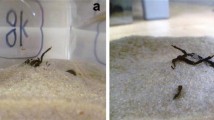Abstract
In the sessile hermit crab Discorsopagurus schmitti, four different feeding techniques are described: antennary beating, body-trap feeding, feeding on wafting particles, and scraping. This species' potential for being a generalist in its diet and opportunistic in its foraging behavior certainly opened the way for a sedentary life, allowing occupation of the unusual microhabitat provided by attached polychaete tubes. Nonetheless, deposit-feeding and/or browsing are the most conspicuous foraging strategies, when both the percentage of behavioral acts performed and the quantity of potential food collected are estimated. The question still remains of whether species' reliance on benthos as the main food source should be regarded as an efficient strategy for a sedentary life, or simply as the heritage of its not-so-remote past as a mobile, and shell-dwelling hermit crab.
Similar content being viewed by others
References
Babcock Gove P (1976) Webster's 3rd new international dictionary. Merriam, Springfield
Boltt R E (1961) Antennary feeding of the hermit crab Diogenes brevirostris Stimpson. Nature 192: 1099–1100
Caine E A (1975) Feeding and masticatory structures of selected Anomura (Crustacea). J Exp Mar Biol Ecol 18: 277–301
Caine E A (1978) Habitat adaptations of Isocheles wurdemanni Stimpson (Crustacea: Anomura: Diogenidae) and seasonality of occurrences in Northwestern Florida. Contrib Mar Sci, Texas Univ Austin 21: 117–123
Caine E A (1980) Adaptations of a species of hermit crab (Decapoda, Paguridea) inhabiting sessile worm tubes. Crustaceana 38: 306–310
Gerlach S A, Ekstrom D K, Eckardt P B (1976) Filter feeding in the hermit crab Pagurus bernhardus. Oecologia 24: 257–264
Gherardi F, Cassidy P M (1994a) Sabellarian tubes as the housing of the hermit crab Discorsopagurus schmitti. Can J Zool, in press
Gherardi F, Cassidy P M (1994b) Macro-benthic associates to the polychaete Sabellaria cementarium bioherm from Northern Puget Sound. Can J Zool, in press
Greenwood J G (1972) The mouthparts and feeding behaviour of two species of hermit crabs. J Nat Hist 6: 325–337
Hazlett B A (1981) The behavioral ecology of hermit crabs. Annu Rev Ecol Syst 12: 1–22
Hughes R N (1980) Optimal foraging theory in the marine context. Oceanogr Mar Biol Annu Rev 18: 423–481
Kunze J, Anderson D T (1979) Functional morphology of the mouthparts and gastric mill in the hermit crabs Clibanarius taeniatus (Milne Edwards), Clibanarius virescens (Krauss), Paguristes squamosus McCulloch and Dardanus setifer (Milner Edwards) (Anomura: Paguridae). Aust J Mar Freshwater Res 30: 683–722
Markham J C (1977) Preliminary note on the ecology of Calcinus verrilli, an endemic Bermuda hermit crab occupying attached vermetid shells. J Zool London 181: 131–136
McLaughlin P A (1974) The hermit crabs (Crustacea Decapoda, Paguridea) of northwestern North America. Zool Verhandl 130: 1–396
Patton W K, Robertson D R (1980) Pair formation in a coral inhabiting hermit crab. Oecologia 47: 267–269
Reese E S (1969) Behavioral adaptations of intertidal hermit crabs. Am Zool 9: 343–355
Roberts M H (1968) Functional morphology of mouthparts of the hermit crabs Pagurus longicarpus and Pagurus pollicaris. Chesapeake Sci 9: 9–20
Schembri P J (1982a) Feeding behaviour of fifteen species of hermit crabs (Crustacea: Decapoda: Anomura) from the Otago region, southeastern New Zealand. J Nat Hist 16: 859–878
Schembri P J (1982b) Functional morphology of the mouthparts and associated structures of Pagurus rubricatus (Crustacea: Decapoda: Anomura) with special reference to feeding and grooming. Zoomorphology 101: 17–38
Schuhmacher H (1977) A hermit crab, sessile on corals, exclusively feeds by feathered antennae. Oecologia 27: 371–374
Scully E P (1978) Utilization of surface foam as a food source by the hermit crab Pagurus longicarpus Say, 1817. Mar Behav Physiol 5: 159–162
Snow P J (1973) The antennular activities of the hermit crab, Pagurus alaskensis (Benedict). J Exp Biol 58: 745–765
Taylor P D, Schembri P J, Cook P L (1989) Symbiotic associations between hermit crabs and bryozoans from the Otago region, southeastern New Zealand. J Nat Hist 23: 1059–1085
Wicksten M K (1988) Antennary cast-net feeding in California hermit crabs (Decapoda, Paguridea). Crustaceana 54: 321–322
Yonge C M (1949) The sea shore. Collins, London
Zibrowius H (1978) Premiere observation du Pagure Calcinus ornatus dans le Parc National de Port-Cros (côte méditerranéenne de France). Trav Sci Parc National Port-Cros 4: 149–155
Author information
Authors and Affiliations
Rights and permissions
About this article
Cite this article
Gherardi, F. Multiple feeding techniques in the sessile hermit crab, Discorsopagurus schmitti, inhabiting polychaete tubes. Oecologia 98, 139–146 (1994). https://doi.org/10.1007/BF00341465
Received:
Accepted:
Issue Date:
DOI: https://doi.org/10.1007/BF00341465




